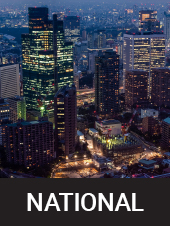MONTREAL – The CEO of a Montreal-based company that uses satellites to monitor methane emissions says interest in his technology continues to reach new heights, even as governments appear to be wavering on their climate commitments.
Since 2016, Stéphane Germain’s GHGSat has launched 14 satellites that roam the skies to detect emissions from oil and gas facilities, coal mines, landfills and agricultural feed lots. Methane is responsible for about one-third of global warming, according to scientists.
GHGSat last month announced a deal with ExxonMobil Corp. to monitor emissions at the oil giant’s sites in Canada, the United States and Asia, and that it raised $47 million in equity and debt financing to help accelerate its global expansion.
Germain says the company has managed to continue its growth despite a U.S. pullback from greenhouse gas monitoring, and a political class that has seemed to cool on climate commitments. Among other actions, the Trump administration is moving to shut down two NASA missions that monitor carbon dioxide and plant health.
President Donald Trump’s budget request for fiscal year 2026 includes no money for the Orbiting Carbon Observatories, which can precisely show where carbon dioxide is being emitted and absorbed and how well crops are growing.
Despite the U.S. government’s apparent waning interest in climate change, Germain says his clients, by and large, are “playing the long game.”
“They understand that in the medium to long term, their end customers really care about climate change and that they are going to have to be both the lowest cost and the lowest carbon footprint producer of oil or gas in order to win in the long term,” he said in a recent interview.
Related Videos
He notes that companies plan their capital expenditures over many years, going “beyond any one administration” and trying to anticipate what regulations will look like in the future.
While U.S. companies remain important clients, he said they are also not the only ones, adding that Europe, Asia and Australia are going “full bore” on climate.

Get breaking National news
For news impacting Canada and around the world, sign up for breaking news alerts delivered directly to you when they happen.
Germain says every gas in the atmosphere absorbs light at specific wavelengths, “like a spectral fingerprint.” And by measuring that absorption, satellites can pinpoint how much gas is in the air over a given industrial site. GHGSat’s clients include governments, industrial emitters and other stakeholders, such as insurance companies.
He says the data can be used to mitigate safety risks, such as leaks, and monitor companies’ carbon footprints. He said GHGSat has also been asked to help search for gas leaks after last year’s deadly fires in California.
GHGSat said this summer it worked on quantifying methane emissions from decomposing matter in palm oil ponds in 12 countries.
Dave Risk, a methane measurement scientist and professor at St. Francis Xavier University in Nova Scotia, said satellites are growing in popularity as a tool to measure methane emissions.
“There’s this big global patrol that’s happening right now where all the satellites are basically working together,” he said. They’re especially useful in countries that are beginning their emissions-monitoring journey, he said, because they often have large unchecked emissions.
However, he notes they don’t work everywhere. In countries like Canada, which already does a relatively good job of limiting methane, emissions from the oil and gas industry are too low for the satellites to detect from hundreds of kilometres away.
Meanwhile, some countries with the largest methane emissions are less likely to want to pay for monitoring. There is also less adoption in the agriculture industry, he said, which is a major emitter through cows, manure management, and rice cultivation.
Risk sees more potential for growth in satellite monitoring in the waste sector, where landfills send methane into the air through decomposing material. Canada has released a series of draft regulations that would require landfills to control methane emissions and ensure landfill gas-recovery systems capture as much of the gas as possible.
Both Risk and Germain note that reducing methane emissions from landfills tends to be inexpensive, even profitable. Methane is natural gas that can be captured and used as a biofuel. “Increasingly (municipalities) are realizing they can tap into it because it’s an alternate source of revenue for them,” Germain said. “So it’s really, really interesting. It’s business and it’s great for the environment.”
Canada has also set a target of reducing oil and gas methane emissions by at least 75 per cent from 2012 levels by 2030, outlined in its 2022 methane strategy.
While Germain says Canada has shown a strong commitment to methane reduction, he acknowledges that polls show climate has slid down the list of priorities for Canadians.
Germain said it’s normal for concerns to ebb and flow, as people worry about immediate concerns such as wars, food security and looming recessions. But he’s optimistic about the future.
He imagines a time when every industrial facility in the world will be monitored for both carbon and methane on a near-daily basis, and when food packaging includes not only nutritional information but also a carbon footprint measure that will inform consumer decisions.
“There’s always this background concern on climate change that we’re going to have to get a grip on, and we can’t just keep kicking the can down the road,” he said.
This report by The Canadian Press was first published Oct. 18, 2025.
© 2025 The Canadian Press



